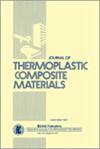三维编织玻璃纤维增强原位聚合热塑性聚氨酯的性能研究
IF 3.4
4区 材料科学
Q2 MATERIALS SCIENCE, COMPOSITES
引用次数: 0
摘要
本研究使用 4,4′-亚甲基二苯基二异氰酸酯(4,4′-MDI)、聚(1,4-丁烯己二酸酯)(PBA)和丁烷-1,4-二醇(BDO)制备了热塑性聚氨酯(TPU)。PBA 作为热塑性聚氨酯的软段。4,4′- MDI 和 BDO 作为热塑性聚氨酯的硬段。研究了异氰酸酯指数、硬段含量和软段分子量对热塑性聚氨酯微相分离、分子量和热性能的影响。以原位聚合的热塑性聚氨酯为基体树脂,制备了三维编织玻璃纤维(GF)增强热塑性聚氨酯复合材料。研究了基体树脂热塑性聚氨酯的结构参数如何影响复合材料的机械性能和微观结构。随着异氰酸酯指数的增加,复合材料的机械性能先增强后减弱,TPU 和 GF 之间的界面粘合逐渐恶化。软段分子量的增加具有相同的变化趋势。随着硬段含量的增加,复合材料的力学性能得到增强。结果表明,当异氰酸酯指数为 1.01、硬段含量为 43%、PBA 分子量为 2000 时,热塑性聚氨酯/GF 复合材料的机械性能最佳,拉伸强度为 289.6 MPa,冲击强度为 141.8 KJ/mm2,弯曲强度为 183.2 MPa,弯曲模量为 10.7 GPa。本文章由计算机程序翻译,如有差异,请以英文原文为准。
Research on the performance of three-dimensional-braided-glass fiber reinforced in-situ polymerized TPU
In this study, thermoplastic polyurethane (TPU) is prepared by using 4,4′-methylenediphenyl diisocyanate (4,4′-MDI), poly (1,4-butylene adipate) (PBA), and butane-1,4-diol (BDO). PBA as soft segment for TPU. 4,4′- MDI and BDO as hard segment for TPU. The effects of isocyanate index, hard segment content, and soft segment molecular weight on TPU micro-phase separation, molecular weight, and thermal performance are investigated. 3D-Braided-Glass Fiber (GF) reinforced TPU composites are prepared by in-situ polymerized TPU as the matrix resin. Investigation is conducted into how the mechanical properties and microstructure of the composites are affected by the matrix resin TPU’s structural parameters. As the isocyanate index increases, the mechanical properties of the composites first enhance and then weaken, and the interface bonding between TPU and GF gradually deteriorates. Increasing the molecular weight of soft segments has the same trend of change. With the increase of hard segment content, the mechanical properties of the composites are enhanced. The results demonstrate that the mechanical properties of the TPU/GF composites are at their best when the isocyanate index is 1.01, the hard segment content is 43%, and the PBA molecular weight is 2000, with the stretching strength being 289.6 MPa, the impact strength being 141.8 KJ/mm2 , the bending strength being 183.2 MPa, and the flexural modulus being 10.7 GPa.
求助全文
通过发布文献求助,成功后即可免费获取论文全文。
去求助
来源期刊

Journal of Thermoplastic Composite Materials
工程技术-材料科学:复合
CiteScore
8.00
自引率
18.20%
发文量
104
审稿时长
5.9 months
期刊介绍:
The Journal of Thermoplastic Composite Materials is a fully peer-reviewed international journal that publishes original research and review articles on polymers, nanocomposites, and particulate-, discontinuous-, and continuous-fiber-reinforced materials in the areas of processing, materials science, mechanics, durability, design, non destructive evaluation and manufacturing science. This journal is a member of the Committee on Publication Ethics (COPE).
 求助内容:
求助内容: 应助结果提醒方式:
应助结果提醒方式:


